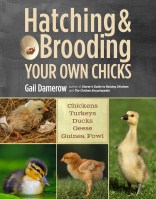Three Reasons We Updated Storey’s Guide to Raising Chickens
What does it mean to publish a ”new edition” of an old favorite? When it comes to Storey’s flagship book on backyard chicken keeping, it’s more than just keeping the information current.

Our flagship series of books on animal husbandry — Storey’s Guides to Raising — was born in 1975, during the Back to the Land movement. It began with a book on raising poultry, another on dairy goats, and a third on rabbits. Over the years the number of titles swelled to 15 as the books became the bibles and textbooks of dreamers and do-ers in the U.S. and around the world. The series has turned overwhelmed beginners into confident pros for the past 43 years, and in 2018, sales of these guides will probably pass 2.3 million copies.
Most of the readers of the Storey’s Guides do not have a farm background. I picture them in a barn at 3 a.m. on a frigid March morning, propping their book open under a bare light bulb, figuring out how to help deliver triplet lambs — and then doing it. Or on an equally anxious June day, hiving their first batch of honey bees while someone reads the steps aloud.
Like any textbook, these volumes have undergone periodic revision to reflect current trends and issues, but the pages have remained the same black and white. Now at last we’re transforming the look of the interior as well, introducing full color through beautiful photography and vivid illustrations.
The best seller of the batch, accounting for more than 20% of the total series’ sales, has been Storey’s Guide to Raising Chickens by Gail Damerow. Given its acclaim, why would we tamper with such a successful product? Here are three reasons.
Our readers require and deserve the best information. For many, chicken raising is their first agricultural venture. Gail Damerow answers the newbie’s questions with clear instructions on feeding, housing, and veterinary care. She helps them understand their birds better with a dictionary of “fowl language” and a discussion of social dynamics within the flock. And she walks readers through the process of brooding chicks at home for the first time.
Our readers also deserve a book that communicates content more clearly than ever. Now, along with the full-color breed photos readers have long wanted to see, they’ll find clearer visuals on how to do things properly and plenty of eye candy, such as photos of the miraculous sweetness of baby animals.


Click and hold the circle, then slide the bar back and forth to compare the Features of a Healthy Chicken from the old edition to the new.
The author is a rock star. In this country and abroad, Gail Damerow is known as the Queen of All Things Chicken. Her impeccable authority and popularity are based on her clarity, her cutting-edge knowledge, and her commitment to providing the very best information. What’s more, she can write. I call her “the Jane Austen of chicken writers” because her prose sings. Whether it’s the best way to clean a coop, the journey an egg takes before it’s laid, or why some feed is no longer recommended for chickens, we devour every word.
The times they keep a-changing. In the past 20 years, farming has responded to the eruption of a major food movement. Many current trends intersect in the chicken coop: consumer demand for organic, grass-fed, locally raised, humanely produced ingredients; and market expansion, with farmers’ markets, CSAs, online purchasing, and so much more. Our readers are coping with ever-evolving issues and expectations.
In addition, the new chicken raisers have a variety of personal goals: healthy, delicious eggs, life lessons for kids, an engrossing mini-world to observe. They seek clear instructions on healthful, sustainable practices, because the loss of even one chicken is unacceptable.


We at Storey are buoyed every day by the extraordinary surge of interest from our audience in the past few years. It shows up in all age groups, from a college student wanting to get onto a farm when she graduates to a retiring baby boomer finally getting his chance to dig deep into a dream hobby, and in all life situations, from a military veteran envisioning a healing future to a village leader in the developing world, exploring ways to make a sustainable community income.
Despite the new look, we expect the pages of this new edition to quickly get dog-eared and underlined. For all of us at Storey, that will be the ultimate sign of success.











